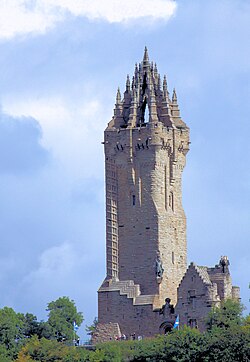Portal:Scotland/Selected articles/83

The National Wallace Monument (generally known as the Wallace Monument) is a 67 m (220 ft) tower on the shoulder of the Abbey Craig, a hilltop overlooking Stirling in Scotland. It commemorates Sir William Wallace, a 13th- and 14th-century Scottish hero.
The tower is open to the public for an admission fee. Visitors approach by foot from the base of the crag on which it stands. On entry there are 246 steps to the final observation platform, with three exhibition rooms within the body of the tower. The tower is not accessible to disabled visitors.
The tower was constructed following a fundraising campaign, which accompanied a resurgence of Scottish national identity in the 19th century. The campaign was begun in Glasgow in 1851 by Rev Charles Rogers, who was joined by William Burns. Burns took sole charge from around 1855 following Rogers' resignation. In addition to public subscription, it was partially funded by contributions from a number of foreign donors, including Italian national leader Giuseppe Garibaldi. The Victorian Gothic monument was created by architect John Thomas Rochead.
The foundation stone was laid in 1861 by the Duke of Atholl in his role as Grand Master Mason of Scotland, with a short speech given by Sir Archibald Alison. Abbey Craig, a volcanic crag above Cambuskenneth Abbey, was chosen as the location of the tower, said to have been the point from which Wallace watched the gathering of the army of King Edward I of England just before the Battle of Stirling Bridge in 1297.
The sandstone tower, which is 67-metre (220-foot) tall, took eight years to build. It was completed in 1869 and cost £18,000 (about £1.8million in 2024).
The monument is open to the general public. Visitors climb the 246-step spiral staircase to the viewing gallery inside the monument's crown, which provides expansive views of the Ochil Hills and the Forth Valley.
